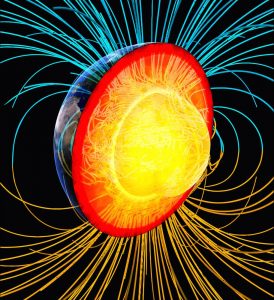
The earth’s magnetic field has been existing for at least 3.4 billion years thanks to the low heat conduction capability of iron in the planet’s core. This is the result of the first direct measurement of the thermal conductivity of iron at pressures and temperatures corresponding to planetary core conditions. DESY scientist Zuzana Konôpková and her colleagues present their study in the scientific journal Nature. The results could resolve a recent debate about the so-called geodynamo paradox.
The geodynamo generating the earth’s magnetic field is fed on convection in the iron-rich outer core of our planet that stirs the molten, electrically conducting material like boiling water in a pot. Combined with the rotation of the earth, a dynamo effect sets in, giving rise to the geomagnetic field. “The magnetic field shields us from harmful high-energy particles from space, the so-called cosmic radiation, and its existence is one of the things that make our planet habitable,” explains Konôpková.
The strength of the convection in the outer core depends on the heat transferred from the core to the earth’s mantle and on the thermal conductivity of iron in the outer core. If a lot of heat is transferred via conduction, there is not much energy left to drive convection – and with it the earths’s dynamo. Low thermal conductivity implies stronger convection, making the geodynamo more likely to operate. “We measured the thermal conductivity of iron because we wanted to know what the energy budget of the core is to drive the dynamo,” says Konôpková. “Generation and maintenance of our planet’s magnetic field strongly depend on the thermal dynamics of the core.”
Measurements of thermal conductivity at relevant conditions proved to be difficult in the past. Recent theoretical calculations postulated a quite high thermal conductivity of up to 150 Watts per meter per Kelvin (150 W/m/K) of iron in the earth’s core. Such a high thermal conductivity would reduce the chances of the geodynamo starting up.
According to numerical models, a high thermal conductivity would have allowed the geodynamo effect to be supported only rather recently in the earth’s history, about one billion years ago or so. However, the existence of the geomagnetic field can be traced back at least 3.4 billion years. This geodynamo paradox has puzzled scientists. “There’s been a fierce debate among geophysicists because with such a large thermal conductivity, it becomes hard to explain the history of the geomagnetic field which is recorded in ancient rocks”, says Konôpková.
The physicists used a specially designed pressure cell that allows to compress samples between two diamond anvils and to heat them simultaneously with infrared lasers, shining right through the diamonds. Konôpková teamed up with Stewart McWilliams and Natalia Gómez-Pérez from the University of Edinburgh and Alexander Goncharov from the Carnegie Institution in Washington DC to measure the thermal conductivity of iron at high pressure and high temperature conditions in Goncharov’s lab.
“We compressed a thin foil of iron in the diamond anvil cell to up to 130 Giga-Pascals, which is more than a million times the atmospheric pressure and corresponds to approximately the pressure at the earth’s core-mantle boundary,” explains Konôpková. “Simultaneously we heated up the foil to up to 2700 degrees Celsius with two continuous infrared laser beams, shining through the diamonds. Finally, we used a third laser to send a low power pulse to one side of the foil to create a thermal perturbation and measured the temperature evolution from both sides of the foil with an optical streak camera.” This way the scientists could watch the heat pulse travelling through the iron.
These measurements were conducted at several pressures and temperatures to cover different conditions of planetary interiors and to obtain a systematic investigation of the thermal conductivity as a function of pressure and temperature. “Our results strongly contradict the theoretical calculations,” reports Konôpková. “We found very low values of thermal conductivity, about 18 to 44 Watts per meter per Kelvin, which can resolve the paradox and make the geodynamo operable since the early ages of the earth.”
Reference
Direct measurement of thermal conductivity in solid iron at planetary core conditions; Zuzana Konôpková, R. Stewart McWilliams, Natalia Gómez-Pérez, Alexander F. Goncharov
Nature, 2016; DOI: 10.1038/nature18009
Note: The above post is reprinted from materials provided by Deutsches Elektronen-Synchrotron DESY.









